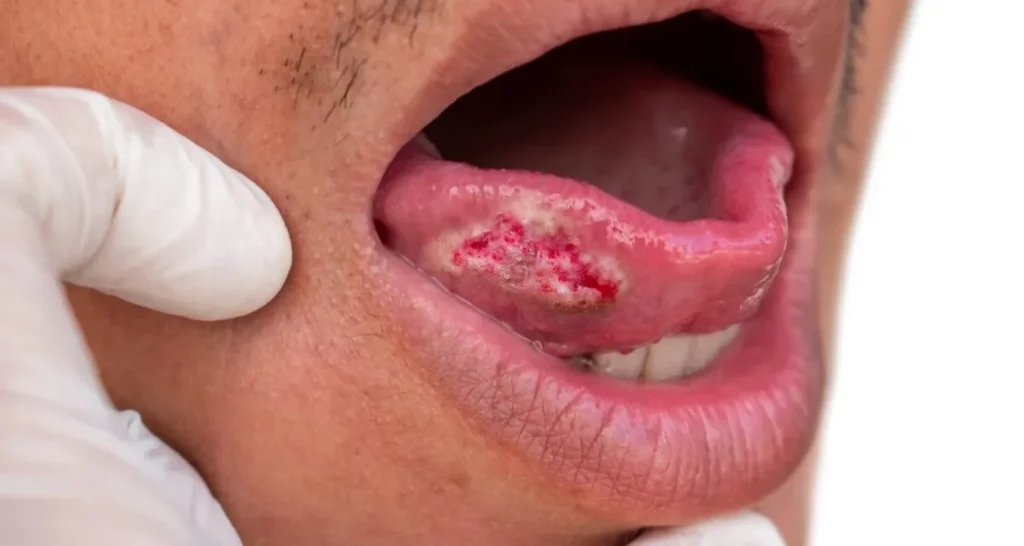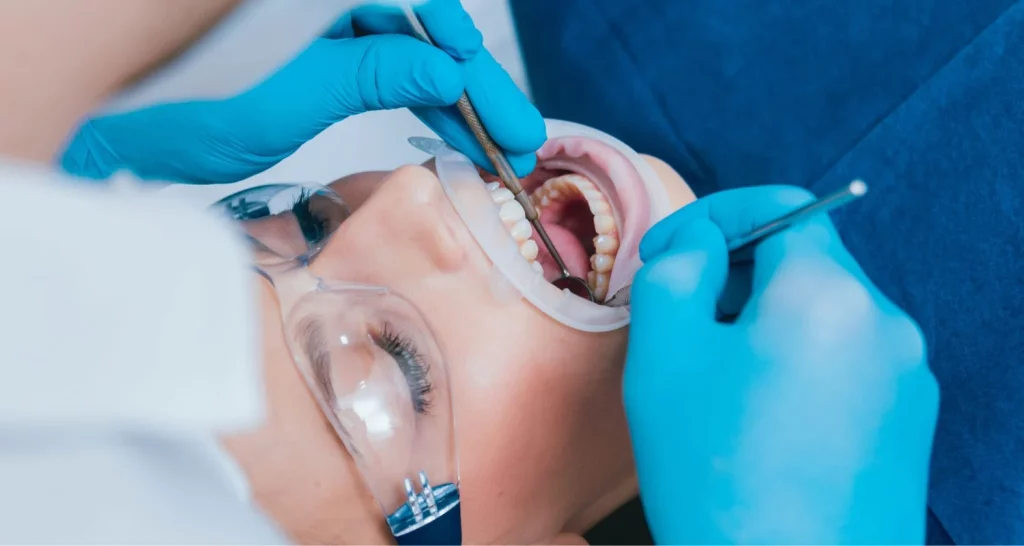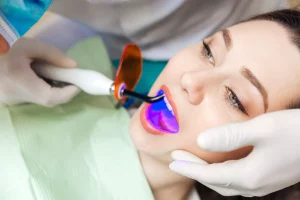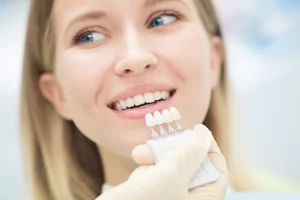Last Updated on: 27th November 2025, 11:26 am
Representing about 3% of all cancers diagnosed annually in the U.S., oral cancer often goes unnoticed until it’s too late. Recognizing the oral cancer signs early on can significantly enhance treatment efficacy and survival rates. This article explores the critical nature of spotting oral cancer signs swiftly and accurately.
Why Focus on Oral Cancer Signs?
Given the seriousness of a late diagnosis, understanding and publicizing the signs and symptoms of oral cancer can save lives. The emphasis on early detection through public awareness and encouraging routine visits to the dentist for screening is vital to treat or manage the changing outcomes of oral cancer.
What is Oral Cancer?
Oral cancer arises when cells in the mouth or the oropharyngeal region develop mutations in their DNA, causing them to grow and multiply uncontrollably. These cancerous cells can form tumors and potentially metastasize to other body parts.
Common sites of oral cancer
It typically presents in the:
- Tongue
- Gums
- Lips
- Inner lining of the cheeks
- Floor and roof of the mouth
- The oropharynx
Importance of Early Detection
Detecting oral cancer signs, in its initial stages not only saves lives, but it also reduces the need for extensive, invasive treatments.
Statistical insight: Act the patient’s functionality and appearance.According to the American Cancer Society, the five-year survival rate for early-stage oral cancer can be as high as 90%, compared to just 20% for late-stage diagnoses.
Risk Factors
1. Who’s at risk?
While oral cancer can affect anyone, certain factors increase risks, such as age (over 50), gender (predominantly males), and ethnicity (higher incidence in white males). Lifestyle choices such as tobacco use (smoking and chewing), heavy alcohol consumption, excessive sun exposure to the lips, and HPV (Human Papillomavirus Virus) infections escalate the risk significantly.
Oral cancer can affect anyone, but certain factors increase the risk of developing it. actors to note:
- Tobacco: Tobacco use, in all its forms, is the main risk factor for oral cancer. Smoking cigarettes, cigars, pipes or chewing tobacco of any kind significantly increases the risk of developing oral cancer.
- Alcohol: Heavy alcohol consumption is also a major risk factor for oral cancer. and the risk increases when combined with tobacco use.
- Human Papillomavirus Virus (HPV): HPV is a virus transmitted from person to person through sexual contact. Some types increase the risk of developing oral cancer, especially cancer of the oropharynx (the back of the throat and the base of the tongue).
- Sun exposure: Excessive exposure to ultraviolet (UV) rays from the sun can increase the risk of developing lip cancer.
- Diet: A diet deficient in fruits, vegetables and other foods rich in vitamins and minerals may increase the risk of developing oral cancer.
- Weakened immune system: People with a weakened immune system, such as those with HIV/AIDS or who are treated with drugs that suppress the immune system, have an increased risk of developing oral cancer.
- Other factors that may increase the risk of oral cancer include older age, male gender, and fair skin.
It is important to note that having one or more of these risk factors does not mean that you will definitely develop oral cancer. However, it is important to be aware of the risks and take steps to reduce them.
Demographics affected: Statistically, men are twice as likely to develop oral cancer as women. Individuals over the age of 50 are at a higher risk, with lifestyle and environmental factors playing crucial roles.
Oral Cancer Signs and Symptoms Checklist
10 key signs and symptoms to watch for:
- Sores in the mouth that do not heal within two weeks
- Persistent mouth pain
- Lumps or thick patches in the mouth, throat, or lips
- Red or white patches in the mouth
- Difficulty swallowing or chewing
- Jaw pain or stiffness
- Teeth loosening without cause
- Voice changes or a persistent sore throat
- Weight loss
- Bad breath not explained by other causes
Screening and Diagnosis
Professional and at-home screening: Regular dental visits for cancer screening are essential for early detection of oral cancer signs. Dentists perform visual and tactile examinations to spot unusual growths or lesions.
Self-examination tips: Monthly self-checks using a mirror can complement professional screenings, especially for individuals at high risk. Look for changes in the color or texture inside the mouth.
Treatment of oral cancer
Treatment for oral cancer depends on the stage at diagnosis, the location and the characteristics of the tumor, as well as the general health of the patient. Early treatments may involve surgery or radiation, while advanced cases might require chemotherapy.
The main treatment options include:
1. Surgery
Surgery is the most common treatment for early-stage oral cancer. The goal is to remove all of the cancer and some surrounding healthy tissue. In some cases, lymph nodes in the neck may also be removed.
2. Radiotherapy
Radiotherapy uses high-energy rays to destroy cancer cells. It may be given before or after surgery, or as the only treatment for small tumors or those that cannot be removed surgically.
3. Chemotherapy
Chemotherapy uses drugs to kill cancer cells throughout the body. It may be given alone or in combination with radiation therapy.
4. Targeted therapy
Targeted therapy t attacks specific cancer cells based on their molecular characteristics. This type of treatment may be an option for some patients with advanced oral cancer.
5. Immunotherapy
Immunotherapy helps the body’s own immune system fight cancer. This type of treatment may be an option for some patients with advanced oral cancer.
It is important to mention that oral cancer treatment often causes side effects. These side effects can vary depending upon the type of treatment and the individual.
Preventive Measures: Lifestyle Changes and Regular Screenings
Oral cancer is a serious health concern, but the good news is that you can take steps to reduce your risk of oral cancer signs. Here’s a breakdown of key preventive measures through lifestyle changes and regular screenings:
Lifestyle Changes
- Ditch tobacco completely: Tobacco use in any form, including cigarettes, cigars, chewing tobacco, and snuff, significantly increases your risk of oral cancer signs. If you’re a tobacco user, quitting is the single most impactful preventive measure you can take.
- Ditch tobacco completely: Tobacco use in any form, including cigarettes, cigars, chewing tobacco, and snuff, significantly increases your risk of oral cancer signs. If you’re a tobacco user, quitting is the single most impactful preventive measure you can take.
- Limit alcohol consumption: Excessive alcohol consumption weakens your immune system and increases your risk of oral cancer.
- Embrace a healthy diet: Fill your plate with plenty of fruits, vegetables, and whole grains. These foods are packed with vitamins, minerals, and antioxidants that support overall health and may play a role in preventing cancer.
- Maintain a healthy weight: Obesity is linked to an increased risk of various cancers, including oral cancer. Aim for a healthy weight through a balanced diet and regular exercise.
- Sun protection for lips: Just like skin cancer, your lips are susceptible to sun damage. Use a lip balm with SPF 30 or higher to protect them from harmful UV rays.
- HPV vaccination: The human papillomavirus (HPV) is linked to certain types of oral cancer. Consider getting vaccinated against HPV, especially if you are young or sexually active. HPV is a sexually transmitted infection. Practicing safe sex by using condoms can help reduce your risk of an HPV infection and potentially lower your risk of HPV-related oral cancer.
Regular screenings:
- Schedule regular dental checkups: Don’t underestimate the importance of routine dental visits. Your dentist can screen for oral cancer signs during your checkup, looking for any suspicious sores, lumps, or changes in the tissues of the mouth.
- Schedule regular dental checkups: Don’t underestimate the importance of routine dental visits. Your dentist can screen for oral cancer signs during your checkup, looking for any suspicious sores, lumps, or changes in the tissues of the mouth.
- Self-exams at home: Get familiar with the normal appearance of the mouth. Regularly examine your tongue, cheeks, gums, and the roof of your mouth for any unusual changes in color, texture, or persistent sores. Report any concerns to your dentist promptly.
By adopting these preventive measures, you can significantly reduce your risk of oral cancer and maintain good oral health. Remember, early detection is crucial for successful treatment. Don’t hesitate to discuss any concerns with your dentist and prioritize regular checkups.
Conclusion
Oral cancer poses a severe risk due to its potential late detection. Early recognition of symptoms, such as persistent sores, unusual patches inside the mouth, and unexpected mouth pain, is crucial for effective treatment. This article has emphasized the importance of awareness and regular dental visits for cancer screening, which significantly improve the chances of early diagnosis.
Proactive measures, including regular check-ups, self-exams, and understanding risk factors, dramatically enhance survival rates. As oral cancer can progress quickly, integrating these screenings into a regular health routine is vital for anyone at increased risk.
Let’s prioritize our health and take preventive action against oral cancer signs by staying informed and vigilant. Early detection is key to combating this disease effectively. Awareness and proactive screenings are our best tools in reducing the impact of oral cancer. Together, we can make a difference in public health outcomes through education and timely action.
Contact Us
If you have any questions about irrigating wisdom tooth sockets or other dental topics, you can contact us at Channel Islands Family Dental as well as our page on Facebook. We look forward to your visit and we will make a timely diagnosis. Our dentists in Oxnard, Santa Paula, Ventura, Newbury Park, and Port Hueneme will be able to guide you toward the best treatment to take care of your health and give you back your best smile.



















